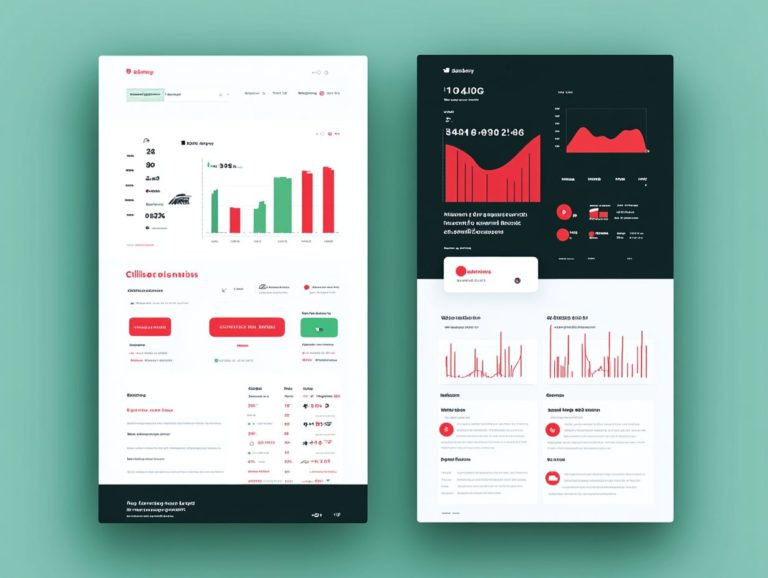Top Metrics to Measure Your Marketing Success
Let's Set Up Your Lead Generation Strategy
Fill out the form below, and our team will get in touch with you to create a tailored solution for your business.
In today s competitive landscape, grasping your marketing performance and understanding key marketing metrics is important for driving growth and achieving success.
This article delves into 15 essential marketing metrics that will empower you to assess your marketing effectiveness, spanning from website traffic to customer lifetime value. Whether your goal is to optimize your campaigns or enhance customer engagement, these metrics provide essential insights that can transform your marketing strategy right now!
You ll also explore how to set goals, the tools that can assist you in tracking progress, and the benchmarks you should aspire to reach. Dive in to uncover how these key performance indicators can elevate your marketing strategy to new heights!
Contents
- Key Takeaways:
- 1. Website Traffic
- 2. Conversion Rate
- 3. Customer Acquisition Cost
- Let's Set Up Your Lead Generation Strategy
- 4. Return on Investment (ROI)
- 5. Customer Lifetime Value (CLV)
- 6. Social Media Engagement
- Let's Set Up Your Lead Generation Strategy
- 7. Email Open and Click-Through Rates
- 8. Search Engine Ranking
- 9. Brand Awareness and Reach
- 10. Cost Per Lead (CPL)
- Let's Set Up Your Lead Generation Strategy
- 11. Customer Retention Rate
- 12. Net Promoter Score (NPS)
- 13. Time Spent on Website or Page
- 14. Referral Traffic
- Let's Set Up Your Lead Generation Strategy
- 15. Click-Through Rate (CTR)
- How to Set Goals and Track These Metrics?
- Let's Set Up Your Lead Generation Strategy
- Frequently Asked Questions
- What are the top metrics to measure marketing success?
- How do you calculate conversion rate?
- What is customer acquisition cost and why is it important?
- What is customer lifetime value and how is it measured?
- Why is website traffic an important metric to measure?
- How do you calculate return on investment (ROI) for marketing?
Key Takeaways:

- Measure website traffic to identify improvement areas.
- Track conversion rate to see how effectively you turn leads into customers.
- Keep a close eye on customer acquisition costs to ensure you’re profitably gaining new customers.
1. Website Traffic
Website traffic serves as an important measure of your online performance, offering valuable insights into user behavior and engagement across your digital platforms.
By diving into web metrics like total visits, unique visits, and returning visitors, you can assess the effectiveness of your campaigns and make informed strategic decisions.
In today s landscape, where digital visibility plays an important role in brand success, grasping these SEO metrics is essential for optimizing your online presence and enhancing customer engagement.
Web analytics tools are critical in this endeavor, enabling you to monitor session duration, bounce rates, and other critical indicators. For instance, a healthy number of returning visitors reflects loyalty and satisfaction, while unique visits signify the reach of your marketing efforts and contribute to your overall campaign success.
Insights derived from session duration can illuminate whether your content resonates with visitors or if adjustments are warranted. These key marketing metrics not only shape your marketing strategies but also refine campaigns designed to boost conversion rates and elevate brand awareness, ultimately crafting a more impactful online presence.
2. Conversion Rate
The conversion rate is an essential marketing metric that shows how effectively your campaigns achieve specific goals. It indicates how well your strategies engage customers and guide them toward taking desired actions.
This percentage is crucial for your business, as it showcases the proportion of visitors who complete a desired action, such as making a purchase or signing up for a newsletter.
To calculate this rate, divide the total number of conversions by the total number of visitors and then multiply by 100 to obtain a percentage. Several factors significantly influence conversion rates, including ease of use. When your website is easy to navigate, users are far more likely to convert.
The quality of your content also plays a crucial role in capturing interest and driving engagement. Implementing effective customer engagement tactics can significantly boost your conversion likelihood. To optimize these rates, marketers often use methods like A/B testing, which compares two versions of a webpage to determine which one performs better, alongside personalized marketing strategies tailored to individual customer preferences, thus enhancing overall email metrics.
3. Customer Acquisition Cost
Customer acquisition cost (CAC) stands as a vital metric, capturing the total expenses involved in acquiring a new customer. This includes everything from marketing costs and sales efforts to lead generation initiatives. It allows you to assess the efficiency of your investment in attracting both leads that are ready for marketing and leads ready for sales.
Understanding the various components that make up CAC is essential for you as a marketer seeking to optimize your strategies. These components typically encompass advertising spend, content creation expenses, and the salaries of your sales teams, all contributing to your customer acquisition cost.
Let's Set Up Your Lead Generation Strategy
Fill out the form below, and our team will get in touch with you to create a tailored solution for your business.
To calculate CAC effectively, you can use the formula: total expenses divided by the number of new customers acquired over a specific period.
If you’re looking to lower CAC without sacrificing lead quality, consider these strategies:
- Refining your targeting methods
- Leveraging automated marketing tools
- Nurturing existing relationships for referrals
Understanding the relationship between CAC and ROI is crucial. Efficient marketing efforts not only reduce acquisition costs but also enhance profitability, offering significant financial advantages for your business.
Start implementing these strategies today to see an immediate impact on your acquisition costs!
4. Return on Investment (ROI)
Return on Investment (ROI) serves as a crucial performance indicator that helps you evaluate the profitability of your marketing expenditures in relation to the revenue generated. This metric gives you the power to assess how effectively your marketing strategies and campaigns drive customer engagement and align with your financial goals.
To calculate ROI, you’ll compare the net profit from a marketing initiative with the costs incurred, expressing it as a percentage. This metric is critical for justifying your marketing expenses, as it clearly illustrates the tangible value of investments in channels such as email, social media, and pay-per-click advertising.
For example, consider a well-executed email campaign that leads to a significant boost in sales revenue, as reflected in your email metrics. Similarly, effective social media strategies can enhance brand awareness and foster customer loyalty, contributing to your long-term profitability.
Ongoing measurement and optimization of your marketing efforts are vital. By regularly analyzing performance data, you can refine your approaches, ensuring that your ROI improves over time and that marketing funds are allocated wisely.
5. Customer Lifetime Value (CLV)
Customer Lifetime Value (CLV) is an essential metric for you, estimating the total revenue your business can expect from a single customer throughout their relationship. This is key to understanding how customers interact with your brand. It provides valuable insights into customer engagement and the long-term effectiveness of your marketing strategies, reinforcing the importance of customer retention rates.
By grasping the concept of CLV, you can allocate your resources more efficiently, targeting high-value customers and maximizing returns on your marketing investments. This metric is influenced by several factors, including purchase frequency, average transaction value, and customer retention rates.
There are various methods for calculating CLV, such as the historical method, predictive analytics, or cohort analysis each offering distinct advantages tailored to your business needs.
Boost your CLV now by focusing on strategies like improving customer retention through personalized communication, loyalty programs, and exceptional customer service, which are vital for increasing brand salience. Additionally, presenting well-timed upsell opportunities that resonate with customer preferences can significantly elevate their lifetime value.
6. Social Media Engagement
Social media engagement is crucial for building brand awareness and nurturing relationships with customers. You can measure engagement through metrics like engagement rate, follower growth rate, and brand mentions. Together, these metrics illustrate the effectiveness of your social media strategies.
These metrics provide valuable insights into how well your brand resonates with its audience. For instance, a high engagement rate shows that your content is not just being viewed; it s sparking reactions and interactions. Meanwhile, consistent follower growth suggests successful attraction of new customers.
Understanding these metrics can transform your marketing strategies! They highlight the necessity of regular content creation and fostering meaningful interactions within your community. Take a cue from brands like Nike, which have harnessed community engagement through their ‘Nike Run Club’ initiatives to inspire athletes. This approach has resulted in heightened loyalty and increased sales, proving that targeted campaigns can yield tangible results and improve brand sentiment.
Let's Set Up Your Lead Generation Strategy
Fill out the form below, and our team will get in touch with you to create a tailored solution for your business.
7. Email Open and Click-Through Rates

Email open and click-through rates are essential metrics that reveal the effectiveness of your email marketing campaigns. They indicate how well your content resonates with your audience and directly impact your overall email ROI.
Understanding how these metrics are calculated sheds light on areas ripe for improvement. Open rates are determined by dividing the number of unique opens by the total number of delivered emails. Click-through rates measure the percentage of clicks on links within those emails against the total unique opens.
Several factors influence these email metrics, including:
- Engaging subject lines that entice readers to open your message
- Audience segmentation for targeted content delivery
- Timing of your email sends to optimize engagement
To boost both open and click-through rates, concentrate on:
- Crafting compelling subject lines that grab attention
- Personalizing your email content for a tailored experience
- Optimizing send times based on your audience’s behavior
- Regularly analyzing your campaign performance to identify effective strategies
8. Search Engine Ranking
Search engine ranking is a crucial element of digital marketing. It dictates your visibility on search engine results pages, directly influencing SEO metrics, keyword rankings, and ultimately, your conversion rates and brand awareness.
This visibility is not just about numbers; it relies on various factors, particularly on-page SEO elements such as keyword optimization, meta descriptions, and header tags. These elements enhance how search engines assess the relevance of your content. Backlinks links from other reputable sites pointing to yours act as endorsements, boosting your authority and credibility in the eyes of search algorithms. Additionally, quality content is vital; engaging and informative material attracts visitors and encourages shares and inbound links.
Monitoring your keyword rankings is essential for gauging success against your marketing goals. This allows you to make adjustments that align your strategies with emerging market trends.
By implementing actionable tactics such as conducting regular SEO audits, optimizing for user experience, and developing a robust content strategy you can significantly enhance your search engine visibility and drive targeted traffic to your site. Start tracking these metrics today to boost your marketing success!
9. Brand Awareness and Reach
Brand awareness and reach are crucial metrics that reveal how well you are recognized in the market. These are measured through impressions, share of voice, and brand sentiment. Understanding these metrics informs your marketing strategies to enhance visibility and customer engagement.
By gauging these metrics, you can identify opportunities for improvement. This is vital for your success! Heightened brand awareness cultivates trust and encourages customer loyalty, ultimately driving increased sales.
To elevate your visibility, consider implementing targeted marketing strategies. Tailored social media campaigns and influencer partnerships that resonate with your audience are effective. Engaging with the community through events or sponsorships can foster positive brand sentiment, creating a strong emotional connection with consumers and cultivating brand advocates who will drive organic growth.
10. Cost Per Lead (CPL)
Cost per lead (CPL) is an important way to measure the total investment required to acquire a lead. This metric offers insights into the effectiveness of your lead generation efforts and plays a vital role in shaping your overall ROI and customer acquisition cost.
Understanding how CPL is calculated equips you to refine your marketing strategies. By dividing total marketing expenses by the number of leads acquired, you can identify areas where your budget can be optimized for maximum impact.
For example, launching targeted campaigns can dramatically reduce your CPL. This ensures that your marketing dollars are directed toward audiences with a higher likelihood of conversion. Effective lead nurturing keeps potential customers engaged and boosts your conversion rates.
Let's Set Up Your Lead Generation Strategy
Fill out the form below, and our team will get in touch with you to create a tailored solution for your business.
This comprehensive approach enhances lead generation while fostering customer loyalty, which can lead to reduced marketing costs down the line.
11. Customer Retention Rate
The customer retention rate shows how well you keep your customers over a specified timeframe. This metric reflects the effectiveness of your marketing strategies aimed at boosting customer engagement and satisfaction.
A high retention rate typically indicates that you re not just meeting but exceeding customer expectations. This loyalty is essential for sustaining long-term profitability, as retaining existing customers usually costs less than acquiring new ones.
To enhance your retention rates, consider implementing strategies like loyalty programs that reward repeat purchases. Making customers feel truly valued is key. Personalized communication can elevate the customer experience by addressing individual needs. Proactive customer service anticipates issues before they escalate, reinforcing trust and satisfaction.
Combining these strategies creates a more connected and loyal customer base, ultimately driving revenue growth.
12. Net Promoter Score (NPS)
Net Promoter Score (NPS) is an important way to measure customer loyalty and satisfaction. It assesses how likely your customers are to recommend your brand to others, offering you invaluable insights into brand sentiment and overall engagement.
To calculate this metric, simply ask your customers: on a scale of 0 to 10, how likely are they to recommend your brand? Based on their answers, you can categorize them into three distinct groups: promoters, passives, and detractors. The real power of this feedback lies in its potential to illuminate areas for improvement and enhance the customer experience.
Strategically harnessing NPS data allows you to customize your marketing initiatives. This ensures they resonate with your loyal customers while addressing concerns voiced by detractors. This approach helps elevate your brand reputation and fosters stronger relationships with your customers.
13. Time Spent on Website or Page
Time spent on your website or a specific page is a crucial website measurement. It provides insight into user engagement and interest in your content. This metric influences overall customer satisfaction and exit rates.
Understanding user interaction is crucial for your success. To extend the time users spend on a page, prioritize the quality of your content. Well-researched, relevant articles with a clear narrative captivate users far more effectively.
Optimizing the user experience and interface can help prevent frustration. It makes navigation intuitive and enjoyable. Incorporating multimedia elements such as videos, infographics, and interactive features enriches your content and captures attention more effectively than text alone. This encourages visitors to delve deeper and fully immerse themselves in your site.
14. Referral Traffic

Referral traffic is a crucial metric that measures the number of visitors arriving at your website from various external sources. It offers insights into the effectiveness of your SEO strategies and brand awareness initiatives.
This type of traffic is vital for evaluating the reach of your marketing efforts. It demonstrates how effectively external platforms funnel potential customers toward your brand. A robust presence across multiple channels amplifies visibility and cultivates trust among consumers.
To boost referral traffic, forge effective partnerships with influencers or complementary brands to cross-promote your content. Start building partnerships today to increase your referral traffic!
Let's Set Up Your Lead Generation Strategy
Fill out the form below, and our team will get in touch with you to create a tailored solution for your business.
15. Click-Through Rate (CTR)
Click-through rate (CTR) is an essential marketing metric that evaluates the effectiveness of your online advertisements and campaigns. It indicates how often people click on your ads, offering invaluable insights into customer engagement and conversion rates.
To calculate CTR, divide the number of clicks on your ad by the total number of impressions and multiply by 100 to express it as a percentage. A higher CTR suggests that your messaging and targeting resonate well with your audience.
Several factors can impact your CTR, such as captivating ad copy, eye-catching visuals, and precise audience targeting. To improve CTR, focus on crafting clear, engaging headlines, using high-quality images, and refining your audience segments based on data.
How to Set Goals and Track These Metrics?
Setting clear goals and tracking your marketing metrics is essential for evaluating the success of your campaigns. This approach provides you with a roadmap for strategic decision-making and continuous improvement.
Structured goal-setting sharpens your focus and gives you the power to prioritize campaigns that yield substantial returns. Each metric be it web traffic, conversion rates, or customer engagement acts as a vital indicator, guiding you on which strategies to amplify or reconsider.
Utilizing analytics tools like Google Analytics or HubSpot streamlines the process of tracking these metrics. These tools furnish you with real-time insights and detailed reports, making it straightforward to monitor your progress. Data analysis is pivotal in refining your marketing strategies, allowing you to adapt based on solid evidence, ultimately driving better results.
What Tools Can Help with Tracking These Metrics?
Utilizing the right tools to track your marketing metrics is essential for gaining insights into customer engagement and campaign performance. This enables you to make data-driven decisions and changes to your strategy with confidence.
By incorporating a variety of specialized software options, you can significantly enhance your strategies and outcomes.
Take Google Analytics, for example. It provides in-depth insights into your website traffic and user behavior, complete with customizable dashboards and real-time reporting features that keep you informed.
Social media analytics tools help you measure content performance across various platforms, offering valuable data on audience demographics, engagement levels, and follower growth rate. Don t overlook email marketing platforms; they often come loaded with impressive tracking capabilities, allowing you to analyze open rates, click-through rates, unsubscribe rates, and user feedback to fine-tune your messaging and campaigns even further.
How Often Should These Metrics Be Monitored and Reviewed?
Determining how often you should monitor and review your marketing metrics is crucial for gaining timely insights and making proactive adjustments to your strategies. This ensures that your business remains agile and responsive to the ever-changing market dynamics, helping to maintain strong brand sentiment.
Different metrics may necessitate varying frequencies for optimal oversight. For example, keeping tabs on sales figures and social media engagement may warrant daily checks, while tracking website traffic and conversion rates could be sufficient on a weekly or monthly basis.
Keep a close watch on these metrics for quicker adjustments! This proactive approach enhances your decision-making capabilities and allows you to identify trends and anomalies, such as shifts in brand mentions, more swiftly. Ultimately, this leads to a better alignment of your marketing efforts with your overarching business objectives.
What Are the Benchmarks for These Metrics?
Establishing benchmarks for your marketing metrics is essential for comparing performance and understanding how your campaigns measure up against industry standards. This process not only facilitates well-considered choices but also allows for strategic adjustments.
These benchmarks include key indicators like conversion rates, click-through rates (CTR), and customer acquisition costs. By focusing on these metrics, you can pinpoint both strengths and weaknesses within your strategies. Analyzing your data against established industry standards gives you the power to tailor your approaches to meet specific goals while maintaining a competitive edge.
Let's Set Up Your Lead Generation Strategy
Fill out the form below, and our team will get in touch with you to create a tailored solution for your business.
The pursuit of these benchmarks underscores the importance of continuous improvement, prompting you and your team to regularly assess performance and refine your tactics. Ultimately, having a clear understanding of these metrics fosters a proactive marketing environment, enabling you to respond swiftly to market changes and shifts in consumer behavior.
How Can These Metrics Help Improve Marketing Strategies?
Analyzing marketing metrics, such as social media metrics and PPC metrics, is crucial for optimizing your strategies and enhancing customer engagement. These metrics provide actionable insights that drive continuous improvement and yield better ROI.
By closely monitoring Key Performance Indicators (KPIs) like conversion rates, customer acquisition costs, and engagement levels, you can pinpoint what truly resonates with your target audience. For instance, a fashion retailer might uncover that social media campaigns attract more traffic than email newsletters, prompting them to funnel more resources into their social media initiatives.
If you’re running an e-commerce platform and notice high cart abandonment rates, you can take proactive steps to refine your checkout process and offer personalized incentives. These adaptations highlight the need to adopt a data-driven mindset, giving you the power to pivot your strategies effectively and maintain a competitive edge in the ever-evolving market landscape.
Frequently Asked Questions

What are the top metrics to measure marketing success?
The top metrics include conversion rate, customer acquisition cost, customer lifetime value, website traffic, social media engagement, and return on investment.
How do you calculate conversion rate?
To calculate conversion rate, divide the number of conversions by the total website visitors. Then, multiply the result by 100.
What is customer acquisition cost and why is it important?
Customer acquisition cost (CAC) is the cost of gaining a new customer. Understanding CAC helps businesses assess spending and determine sustainability.
What is customer lifetime value and how is it measured?
Customer lifetime value (CLV) refers to the total money a customer is likely to spend during their relationship with your business. You can calculate it by multiplying the average purchase value by the average number of purchases per year, and then by the average customer lifespan.
Why is website traffic an important metric to measure?
Website traffic shows how many people visit your site. This metric helps you understand your reach and the effectiveness of your marketing efforts.
How do you calculate return on investment (ROI) for marketing?
To calculate ROI, divide the net profit from marketing by the total marketing cost, then multiply by 100. Knowing your ROI is crucial for making smart marketing decisions.






